|
Have
you ever had a friend or relative die, and wished
you could have kept them at home for
a day or two, to take care of the body yourself
and say your farewells without pressure?
In fact, you can.
Caring
for your deceased loved one at home is simpler
than it may seem, but certain tasks (including
the filing of paperwork) do need to be
done at specific times — see General
Timeline below. Embalming
is usually not necessary, and in most places there
is no legal requirement to make use of a funeral
home.
Post-death
care
may include getting the body from the hospital
or hospice (unless your Death Journeyer
died at home); washing and dressing the
body; cooling it with dry ice or Techni-Ice/Cryopak
blankets; making or buying a simple shroud or
casket, and decorating it as you choose; putting
the body into the casket or shroud; and then finally
transporting it to a crematory or burial ground.
See
Post-death
Care at Home below.
Resources
to support you in post-death care can vary between
provinces/territories. The primary ones
are available at Resources
Pre-Death and Resources
Post-Death. Please check
with your local Hospice or other advocacy groups
to find out what resources (such
as grief counselling) are available in
your area. If you have difficulties,
please contact
us — we may have, or be able to find,
further specific information.
Summary
Overview
of At-Home Post-Death Care and/or Home Funerals
Right
to care for your own dead Most
North Americans — especially urban people
— assume that the law requires that the body
of a deceased must go to a commercial funeral
home shortly after death. In fact,
in most cases, this is not true — families
have the right to care for their own dead until
the body is buried or cremated. Again
— in most cases — you also have the
right to bring the body to your home after your
person has died in a hospital, hospice
or residential care facility. Post-death
care is not that difficult, nor that different
from pre-death care — and most of the documents
needed are available to families from your local
Vital Statistics office.
It
is important to note that
the law allows for multiple options (such
as the rights above) that are not actually
spelt out in it — that is, it does not restrict
such options. Much of
what is considered 'law' in our culture is only
common practice — which then leads to misconceptions
of what is possible and what is not; and even
funeral directors are often misinformed by their
training.
For example, in B.C.,
the only restriction on time of burial or cremation
is that a body cannot be cremated before
48 hours (to allow for investigation
of cause of death, if necessary).
Also, the following statement from the city of
Prince George, B.C., clarifies that: "There
is no law that states a specific time-frame for
burial. The timeline is usually determined
by the need to secure all permits and authorizations,
notify family and friends, prepare the cemetery
site, and observe religious and cultural rituals."
("A
Death in Your Family")
Many
people find that keeping their person
at home and doing the post-death care themselves
(or with the guidance of an
alternative death-care provider) is
a significant last act of loving care. It
allows for the whole of the family (including
children), and their closest friends,
to organize the post-death events according
to what is personally meaningful to them (and/or
the death journeyer). Thus
they can create a personalized continuum between
the pre-death process, and the final burial/cremation
and funeral/memorial. It
can also be considerably less expensive than
using a funeral home -- except for direct
creamtion where the body is moved to the crematorium
immediately after death. |
|
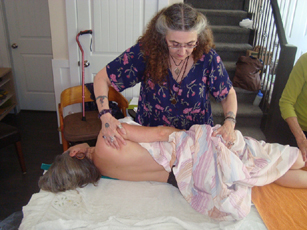 Rolling
the Body in Preparation for Washing the
Back
Rolling
the Body in Preparation for Washing the
Back |
|
|
|
| There
are definitely situations in which delegating
post-death care to a funeral home may be appropriate: |
| |
 |
|
It
may be required by, or customary to,
your faith. |
| |
 |
|
The
death occurred as the result of a disfiguring
accident, or if the Death Journeyer
died alone and wasn't found for days
afterwards (in which
case the body may have begun to decompose). |
| |
 |
|
The
family may wish the funeral held elsewhere
— either where more of them can
attend, or in order for the Death Journeyer
to be buried in the family plot (in
which case, embalming may be necessary
for the sake of transporting the body). |
| |
 |
|
There
may not be any suitable home (belonging
to family or friends) in the
area, to bring the Death Journeyer home
to. |
| |
 |
|
Or
it may simply be the case that it would
be awkward for any family member or
friend to do the post-death care, because
of family dynamics or their own practical
situation. |
| |
| Further
Notes on preparing for a home funeral: |
| |
 |
|
The
body can be brought directly home from
the hospital or residential care facility
— if a family member or friend
is willing to take on post-death care
— but the transfer must be authorized
by the executor, or next-of-kin (if
an executor has not been named). |
| |
 |
|
It
is possible that a funeral home facility
— once in possession of the deceased
body — will allow the body to be
taken to the family home for a short
period of time (2-3 days).
However, they might insist on embalming
the body first. In such
a case, the family needs to consider
whether the value of having the body
at home outweighs the carbon-footprint
of embalming. |
 |
Funeral
homes who use more ecologically-friendly
products are listed on the Green Burial
Council site under Find
GBC Providers. The
degree of 'greenness' is denoted by
the number of green leaves beside a
listing — graduating from pale
to darker green, with the darker leaves
given to those who offer the most ecologically-friendly
options. |
 |
Even
if you have already pre-paid for funeral
arrangements with a specific funeral
home (sometimes called
a 'pre-need' or 'pre-planned' contract),
you may be able to cancel the contract
if you later choose to have a home funeral. It
is likely, however, that there will
be a penalty for doing so; and it should
be clearly written into the contract. Check
your province/territory's Consumer Protection
agency for further clarification of
rights re cancelling contracts, as each
has slightly different rules (see
Consumer Protection agencies for
each province/territory on our Resources
— Post-death page). |
|
(return
to top)

Canadians
can do it at home
It is important that Canadians know that
at-home family-based post-deathcare is a realistic,
accessible, and legal option.
| |
 |
|
Especially
with the advent of extensive hospice/palliative
care, more people can die at home with all
the 'comfort care' that the Death Journeyer
requires. Where such care is available,
the palliative-care teams can — within
the person's own home — supply
most of the nursing/caregiving services and
basic medical equipment that would otherwise
be provided in a hospital or hospice. |
| |
 |
|
If
the Death Journeyer dies in a hospital,
hospice, or residential care facility, you
have the right to take the body home after
death — although you may need a Permit
for Burial or Cremation, and possibly a
Permit to Transport the Body, with you.
[Note:
The Permit to Transport the Body may also
be known by other names, such as Private
Transfer Permit or Body Transport Permit.
It may not be required
in your province —
to date, we are only aware of such permits
being required in B.C. and Ontario. See
the CINDEA page on Resources
in Canada —
Post-death,
section Legal
Information and Regulations] |
| |
 |
|
Washing/dressing
the body is usually fairly simple (instructions
are given in the
Post-death Physical Care (PDF) and videos
below). There are, in fact,
many things done when the Death Journeyer
is still alive (inserting IVs,
changing bandages, caring for dry mouth)
that may not need to be done afterwards. |
| |
 |
|
Rigor
mortis usually takes several hours to set
in (2-7 hours), and
relaxes again within about 36-72 hours —
depending on various factors re the deceased's
size/etc. and the environmental conditions. Post-death
care can continue during the early stages
of rigor mortis. |
| |
 |
|
A
dead body can be kept at home for 3-5 days,
without significant deterioration, with the
use of fans, air conditioining and dry ice
— or with Cryopak blankets (order
from Cryopak)
which are safer to use than
dry ice. Notably, Cryopak ice blankets are also commonly available in \many large stores, especially during the summer. |
| |
 |
|
All
documents and permits are available to families.
[ See
Resources
in Canada —
Post-death,
section Legal
Information,
for govermental and other links for access
to these documents.] |
| |
 |
|
As
long as a casket meets some general standards,
you can make it yourself — or buy a standard
cardboard/pressboard one and decorate it according
to your own wishes. There are
casket-building companies who are beginning
to offer ecologically-conscious options —
made from wicker, recycled wood or cardboard,
etc. You also do have the right
to buy a casket from a business other than
a funeral home (for some options,
and blueprints to make your own, see Eco-Friendly
Coffins, Shrouds, and Urn or CINDEA
's Shroud
patterns).
Some cemeteries also accept simple
shrouds (i.e. without a casket
at all) — and for some religions,
shroud-burial is, in fact, a requirement. |
CINDEA has attempted to provide the necessary
information on how to deal with all of the elements
of at-home post-deathcare — on this page,
and on its 'Resources in Canada' pages.
(return
to top)

A
Short History of Post-Deathcare and Funerals
|
Delegating
post-death care to funeral homes
In North America, it has become customary
for professional funeral directors to handle
all care of the body after death, including
the documentation and funeral ceremonies
— so much so that most people believe
it to be required by law. In
fact, in most cases, it is not required
— the primary exceptions being when
|
| |
 |
|
the
body needs to be transported a long distance,
(and therefore may need to
be embalmed), |
| |
 |
|
non-organic
devices (pacemaker, etc.)
may need to be removed before burial or cremation,
or |
| |
 |
|
there
is a question as to the cause of death (in
which case the body needs to be investigated
by a coroner). |
|
Even
in these cases — depending on the specific
circumstances — you do not need to
use a funeral home. For example,
if the body is being transported immediately
and is kept cool, it may not need to be
embalmed to be taken to another city or
province.
Theoretically,
there is no reason why an autopsied body
can't be brought home after the coroner
has closed the body. If
your person's death is likely to
be autopsied, it is
wise to check out the rules of your municipality
or province in advance: and if you are having
difficulty getting clear answers or permission,
please feel free to contact
us — and we will do as much as
we can to help you figure out how to have
your person's wishes granted. |
(return
to top)

|
The
tradition of embalming
Embalming has become
so popular that many people believe it also
to be required by law — which it is
not, except perhaps when the body needs
to be transported long distances. [Note:
in some funeral homes, bodies are embalmed
to "allow" for formal viewing/visitation
—
even though a cremation will happen soon
after the death. However, informal
visitation with no embalming can often be
arranged. Embalming may
be required, if you choose to take the body
home after the funeral home has taken possession
of it.]
Since
embalming can only be done by licensed professionals
in certified facilities, it became common
to assume that a deceased body had to be
moved to a funeral home soon after death,
in order for it to be embalmed. It
is notable, however, that Jewish, Muslim,
Hindu, Bahá'í, and other traditions
forbid embalming — and often require
that the body be buried within 24 hours,
which would preclude embalming in any case.
In many countries, whether or
not the body is embalmed, it is always returned
to the family home — if the death journeyer
died in a hospital or residential care facility
— for the final ceremonies. |
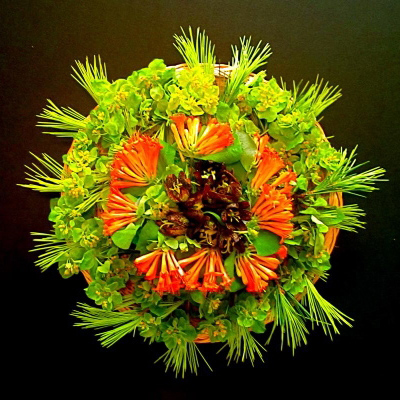 Earth
—
remembrance flower mandala by Elli
Boray
Earth
—
remembrance flower mandala by Elli
Boray
|
|
(return
to top)

All
of these elements became a status symbol —
as family members were encouraged (and
sometimes even intimidated) to choose the
more elaborate services, ornate caskets, prominent
gravesites, and ornamental tombstones (even
if cremated, the ashes may be buried under a tombstone)
— designed to 'prove that they were truly
honouring their loved one'. As
a result, even fairly modest funeral and burial/cremation
services can easily cost as much as $8,000 or
more (especially if buried),
once all of the services are tallied.
(return
to top)

| Denying
the reality of death
Our society has developed
a set of conventional practices intended to
remove death from our consciousness. When
a dead body is moved to a funeral home, it
disappears — although we know it isn't
true, it can be easier to (unconsciously)
believe that our person has simply
gone away on a long trip. If we
were not able to be present at the death or
shortly afterwards to say our final 'goodbyes',
funeral homes may charge $100-$200 for even
a single-person visitation/viewing.
If we do see the body again (at
the visitation or open-casket funeral),
it has been made-up to look like our loved
one is alive and only sleeping.
All of this is actually meant to encourage
us to believe that the death is not entirely
real — that our person's last
breath was not final. |
|
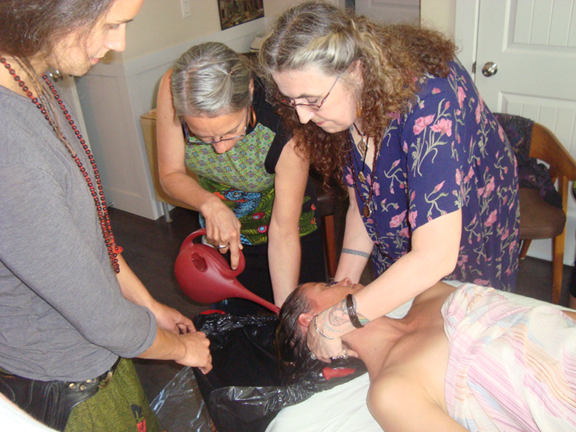 Washing
the Hair
Washing
the Hair |
We
may have contributed our own personal eulogies
at the funeral; but customarily, the main rite
is spoken by the clergy or funeral director —
who may have never known the person that we treasure
so deeply, nor witnessed any of their moments
that are weaving through our minds as we recognize
that these will never be shared again.
Our
person lies in a non-customized casket
— not made by our hands, nor placed there
by us. We may watch the casket being
lowered into the grave — but not cover it
with shovels full of sweat and tears, knowing
that this act is the final 'goodbye'; or watch
it being rolled into the cremation furnace —
but not push the button that ignites the flames
that consume it so finally. [Note:
even watching the casket lowered into the grave
or rolled into the cremation chamber has been
discouraged —
or even disallowed —
but that is changing in recent years.]
(return
to top)

Death
is no longer part of the cycle of life
When we delegate post-death
care to a commercial funeral home, we separate ourselves
from the reality of the death. As a
result, we isolate ourselves from the concept of
death being a sad, but necessary, part of the cycle
of life. We perpetuate the cultural
myth that we (if not other people)
will live forever; and in doing so, fail to face
our own mortality or prepare for our own dying/death.
Also — as so many near-death survivors
have affirmed — when we face death, it significantly
changes the value we put on our daily lives.
|
Moreover,
our grieving can become a private and lonely
affair — uncomfortable to share with
even our closest family and friends, and
hard to commemorate with them in the years
to come. Friends who are not
close relatives may be left wondering whether
it will be acceptable to the family to mention
the death on its anniversary — even
knowing that that acknowledgement might
be intensely meaningful to the family —
for fear of inadvertently offending, if
the reference to the death is unwanted.
And for the close family themselves,
if they did not call their friends together
to share grief at the time the death occurred,
they may feel that they have no right to
do so on following anniversaries either.
The very act of caring
for the body ourselves creates a community
of grieving.
In
effect, our culture (albeit
somewhat inadvertently, since the intention
is actually to protect us) tends
towards encouraging us to continue on as
if the death never happened — and although
not really intending to, as if our loved
one never existed (except,
perhaps, for a tombstone acknowledging where
their body was buried). For
most people, the worst fear about their
eventual death is not the pain and suffering
involved in dying (especially
now that modern medical technology can alleviate
most of that), but the fact that
we will no longer exist — even in the
memories of our dearest friends. |
|
When
you're caring for someone at home you and
your family need support also.... It's
easy to imagine that you're the only one
with such your worries, as we talk so little
about death and dying in our society. Be
assured though that others in your situation
have very similar concerns. It's
just that people don't always have the courage
to talk about them. [From
Virtual Hospice article Dying
at Home — My father would like to die
at home. What can we expect?
]

Toasting
the Death Journeyer
during a home funeral |
(return
to top)

Continuance
of post-death care at home
However — especially
in some rural areas, or in intentional communities
— the tradition of the family caring
for the deceased has continued into the present
day. Particularly in the 1990s,
even urban families began questioning our
cultural funeral customs for a number of reasons:
|
|
Dying
at home helps not just the dying patient,
but society as a whole...more free hospital
beds for patients who can benefit from hospital
services. Additionally, "aggressive,
expensive, painful and futile" care
in hospital is often avoided when patients
are able to die at home. Donna
Wilson, professor of nursing at the University
of Alberta — from the CBC News project
A
Good Death, a co-production with students
from the Graduate Program in Journalism
at Western.

About
25 percent of all health-care costs are
devoted to caring for patients in their
last year of life.... Almost
70 percent of people die in the hospital,
including some in high-tech intensive-care
beds, which cost about $1-million a year
to operate. Many patients fail
to complete advance directives or communicate
preferences.... they could be subject to
costly, invasive treatments they did not
actually want. Lisa
Priest —
November 29,2011 How
much does dying cost Canadians? [from
the Globe and Mail
'end of life' series] |
| |
 |
|
Items
and services that weren't necessarily appropriate
(or that didn't fit the values
of the death journeyer or their family)
added to the overall cost. |
 |
Given
the demographics of the baby-boomer generation
and their increasing longevity, families became
concerned that personal and health-care funds
might not be available to their children or
grandchildren because funds are used for
|
| |
|
 |
a series of what are likely to be unnecessary
treatments, and artificially maintaining lives
beyond any 'quality of life' (it
is estimated that a person uses twice as many
health-care dollars in their last year of
life, as in the whole of their life beforehand)
— and |
| |
|
 |
customary,
but unnecessary, post-death services. [Memorial
societies were created to reduce these costs,
and support families to only choose what they
felt was appropriate or necessary from a funeral
home.] |
 |
Although
funeral directors are generally caring, compassionate
individuals, they have limits imposed on them
as to what they can offer, in terms of personalized
choices — by law, customary practice,
company policy or their professional association's
standards. |
(return
to top)

Alternative
Death-care providers
As a result, some individuals
— with direct experience of, and/or a particular
concern for, an at-home/family-based post-death
process — began offering their services publicly,
training others to support families in the same
way (Final
Passages in the U.S. being amongst the first
to do so), and even publicizing the necessary
information on post-death care on the web (see
our Resources in Canada
— Post-Death page — Legal
Information and Regulations, Resources
Elsewhere —Post
-Death Care information,
and our own PDFs on Basics
on Post-death Care At Home below).
Those who focus on post-deathcare support are
most often called home funeral guides — although
pan-death guides and thanadoulas also include
this support in the whole pan-death continuum
of their practice, and some death doulas may offer
post-deathcare as well.
(return
to top)

Why Consider an At-home Family-based
(Home Funeral) Option
What
is a 'Home Funeral'?
By dictionary definition, a
funeral is a ceremony, or group of ceremonies,
held in connection with the burial or cremation
of a dead person. It doesn't include
the other elements of care or documentation that
funeral homes provide (washing/dressing
the body, embalming, make-up added to the face,
Death Certificates, etc.).
(return
to top)

| Is
use of a funeral home necessary?
In our culture, dealing with a dead body is
considered both taboo and dangerous to the
health of the caretakers (although
this is only true with highly infectious diseases
— in which case, it is unlikely that
the deceased would have died at home).
Therefore, it has been assumed that only specially
trained professionals are capable of handling
a dead body. |
|
Most
people worry that their final days will be
filled with pain and agitation. Usually
the opposite is true. In the days
and hours before people die, they typically
spend most of their time asleep or resting.
It's rare for pain to get worse
or for distressing symptoms to appear. Most
often, the various body systems just gradually
and quietly shut down.
[From Virtual Hospice
article Dying
at Home — My father would like to die
at home. What can we expect?] |
In
fact, it wasn't until the early 20th century (and
after embalming was popularized in WWI, for soldiers
being returned home for burial) that dead
bodies were customarily moved into funeral homes
shortly after death. Until then
(and for tens of thousands of years
of our species' history beforehand), most
post-deathcare was done at home — perhaps
with the assistance of a local doctor or midwife;
but in any case, with the help of those in one's
community who had experience dealing with dead
bodies.
Practically,
caring for a dead body itself is not that different
from caring for the same person while they were
dying — and in fact, often much simpler (see
Basics
on Post-death Care At Home PDF below, as well
as Caitlin Doughty's "Ask a Mortician"
video "Are
Dead Bodies Dangerous?").
Especially if the Death Journeyer had dementia,
or another condition that prevented them from
doing any of their own care, it is likely that
the family caregiver has been doing equally extensive
and intimate care for them (e.g.
cleaning private parts) to what is required
by post-death care.
| Given
all of the above, it is quite possible for
family members, or a group of friends, to
do all of the post-death care — whether
the death journeyer has died at home, or in
a hospital or residential care facility —
with or without the support of a DWENA practitioner. |
|
Today
her greatest wish is that "dying might
become a community event again.... it would
be good to see it become a natural part of
daily life." [From
"The silence of
the dying" Sunday Times (PDF
article), on
Sara Douglass —
nurse and fantasy-writer
— on dying from ovarian cancer.] |
(return
to top)

Choosing
a casket
Most funeral homes carry
(or show) only a limited
number of less ornate caskets, and encourage the
family to choose from amongst their wider array
of more elaborate ones. By law, you
do not have to choose any of them, and can order
your own from another business. Most
funeral homes carry cardboard caskets (generally
used for cremation) — and even though
you are unlikely to see them in the showroom,
you have a right to buy one and decorate it according
to your wishes. Some cemeteries may
refuse to bury cardboard caskets; but with the
growing trend of green burials, they may be open
to doing so simply to build some PR as 'ecologically
conscious'.
(return
to top)

'A
la carte' Services
Some funeral homes may
be willing to provide one or two specific services
(rather than their usual full range
of care) if you choose to do most of the
post-deathcare at home. Of course,
that is not what their business is set up for.
However, particularly those funeral
homes focusing on simpler or less expensive services
may recognize that — as at-home post-deathcare
becomes more popular — they can provide an
important support service. For example,
if the Death Journeyer has a pacemaker, the funeral
home may be willing to remove it before burial/cremation.
In all likelihood, they would wash
and re-dress the body as part of that procedure,
but then might be willing to release the body
(with proper documents)
to be taken home for the 'lying in honour'/visitation
before burial or cremation. They might
also be willing to provide transportation services,
if you don't have a vehicle available that is
appropriate for transporting a body; or take over
the paperwork.
It
would be wise to contact the funeral homes in
your area, well in advance of the death, to find
out which ones might provide 'a la carte' services,
in order to avoid potentially uncomfortable negotiations
at the time of deepest grief. If you
have a DWENA practitioner locally available, they
may be able to provide information on which funeral
homes are most likely to offer 'a la carte' services. Your
hospice may also be helpful in finding supportive
local services.
(return
to top)

Comparative
costs of funeral home versus at-home post-death
care [Downloadable PDF]
Note:
the above table only uses two particular funeral
homes' prices (circa 2014, now more) —
two of the less expensive ones in B.C. Some
of the more expensive funeral homes will charge
higher fees for most of these items — possibly
more than double the prices given on the left
side of this comparison. It
is only intended to give you a very general idea
of the parallel cost of the most inexpensive funeral
home usage, as compared to 'Post-deathcare
by family at home '. You will
need to compare prices with funeral homes in your
own area. The 'Post-deathcare by
family at home ' column does not include any
fees or donations to a private alternate deathcare
provider, and neither column includes the costs
of the actual burial or cremation (which
will be variable depending on where you live;
and what kind of casket and burial plot you choose,
if choosing burial) or required taxes.
(return
to top)

|
Saying
goodbye Many
people find — despite some initial
concerns about the taboo against handling
a dead body — that continuing to care
for their loved one after death is a critical
part of accepting the death, alleviating
the shock/numbness (common
even if the death is expected), and
beginning to release the grief.
Hospitals
and residential care homes — now recognizing
this — may offer several hours for
the family to 'say their goodbyes' before
moving the body: and even some funeral homes
may recommend not calling them until hours
after the death. However, several
hours may not be long enough — and
simply 'saying goodbye' may not have the
same effect as the testament of love that
one gives when actually caring for the body,
hands-on, after death.
Many find doing post-deathcare for their
person to be very comforting —
and sometimes a deeply sacred act; and traditionally,
it has long been considered one of the final
acts of respect to the death journeyer.
|
|
AfterWards
Take her not from me.
Let it be this hand
Who wipes the folds of her flesh —
A final encore to fading days.
With each tender stroke,
May her seasoned soul unwind its threads
from this mortal coil.
With each grieving caress,
May her enduring love weave more tightly
into the whole of my being.
Take
her not from me,
Until the last essence of who she was
is
truly gone,
And I have captured only what she left for
me —
In this hand and heart.
Pashta
MaryMoon |
(return
to top)

|
Community
of Grieving
In Western culture, grief
can be very isolating. Especially
over the past century, we have lost many
of the traditions that our ancestors brought
from other cultures, which provided ways
of grieving within a community and/or ethic
setting. When we lose soneone
close to us, we often feel that we are losing
a significant part of ourselves — and
truly, our personal world has
changed. This can end up
creating unfathomable wells of grief —
that we ourselves don't entirely understand,
and may be afraid of delving into. We
tend to assume that no one else would understand
the depth — or kind — of grieving
we are dealing with, leaving us feeling
very isolated in our bereavement. And
out of empathy or embarrassment, we may
be worried about setting off a 'grieving
episode' in another mourner, by speaking
about our own feelings — so we don't,
and then inadvertently contribute to their
further isolation.
The
actual act of doing hands-on post-deathcare
tends to evoke tears, and stories, and even
humour — that cannot be held back;
and so become shared, while doing a particular
task together. In the process,
post-deathcare — done at home — can
also create a 'community of grieving
' that may last for years to come. Families
and friends have the opportunity to become
comfortable with sharing whatever element
of their grief is coming to the surface
at the time — creating a 'safe space'
to do so again later, one-to-one. They
are also more likely to visit the grave,
or where the ashes are spread, together
later; or plan other kinds of 'anniversary
of the death' events — continuing the
'community of grieving ' in whatever
way, and for as long as, is needed. |
|
...
our grief-stricken loved ones (are
left) feeling isolated, judged, misunderstood,
and alone. And though grief is deep and personal,
it is not meant to be experienced all alone. In
fact, families and friends who are able to
share their grief find they have gained a
depth to their relationship that would never
otherwise have been found. (The
Do's & Don'ts of Helping Others Through
Grief, April 14, 2012 by Dr. Christina
Hibbert -- see also Talking
with Children and Youth about Serious Illness) |
(return
to top)

|
Children
and Death Our
culture teaches us to protect children from
the reality of death. Children (particularly
younger ones) live in a world of
immediacy, action, and direct consequences
— not abstract theory. The
combination of their infinite imagination
and lack of habituation to 'basic life rules'
can result in children taking on responsibility
for the death — as if something they
did caused it (not obeying
a parent, saying something untoward to their
friend, etc.), or at least that there
was something that they could/should have
done to avoid it. They often
don't reveal this sense of responsibility
until much later in life (and
often initially, only to a counsellor)
— after they have carried the guilt
or shame of it through all of their developing
years.
In
fact, children are more likely to understand
death as a normal process — and NOT
take responsibility for it — if they
are allowed to be directly involved as much
as possible with the whole of the pan-death
process. This would include
direct contact with the death journeyer
before death and during the death vigil;
and then being involved (in
appropriate ways for their age) in
the post-deathcare of the body, decorating
the casket, and participating in the actual
burial and the funeral or memorial services.
|
|
...
even very young children can sense when something
is wrong within the family.... Children
who are shielded from the truth are likely
to worry, rely on overheard bits of conversation,
or make up something in order to make sense
of the unusual behaviours they’re observing.... Many
experts who work with children and youth believe
that young people are better able to cope
with situations if they know what is happening....
No matter how difficult a situation
seems, children and youth are remarkably able
to cope and integrate illness and death into
their lives.... Often families do not want
children to be around someone who is dying.
However, this avoidance may lead
to more questions and possibly some fears
developing about illness and the end of life.
Making death a natural part of
life for children and youth will help them
integrate this experience into their lives.
[From Canadian Virtual
Hospice article "Talking
with Children and Youth about Serious Illness"
] |
As
much as this may seem a very somber activity for
a child, they can take delight in the simplest
offerings to the Death Journeyer (before
and after death): and this allows them
to remember the death with joy, as well as sorrow.
This participation then also makes
it easier for them to take part in later commemorations
(one grandmother has her grandchildren
make flower wreaths at the anniversary of their
grandpa's death), and thus they can remember
the Death Journeyer with a sense of joyfulness
and peace.
Ecological
footprint of home funerals/community deathcare
Almost
all of the supplies needed for a home funeral/community
deathcare are either already in the home or can
be reused after the deathcare — therefore,
there is very little that need to be disposed
of. One supportive funeral director
told us that the disposables for one body, cared
for in a funeral home, equals two large garbage
bags — gloves, sheets, gowns, masks,
etc. For some families, committed
to ecology in the rest of their lives, the ecological
advantages of a home funeral/community deathcare
are significant.
(return
to top)

Basics
on Post-death Care At Home
The
many details of post-deathcare may seem overwhelming,
but it is simpler than it appears. CINDEA
has produced a series of short videos, shown below,
that demonstrate the primary steps of what needs
to be done (because "a picture
is worth a thousand words"). The
written instructions in the PDFs "Post-Death
Physical Care" and "General Timeline"
(below the videos) describe
the process in more detail.
Most Death Journeyers have a wider support network
than you may at first be aware of (friends,
faith communities, political/social-issue groups,
online communities,
hobby/interest groups, etc.) — and
those people may appreciate an opportunity to
help. There may also be a pan-death
guide or other DWENA practitioner available in
your area to guide you through the post-death
care. See our DWENA Practitioners page for Canadian Death Midwifery Practitioners, Death Doulas, Home Funeral Guides and Funeral Celebrants in each provinces..
Legal
requirements are slightly different in each province/territory.
The required
documents are usually only issued to the next-of-kin,
the designated Representative or power of attorney,
or (post-death) the executor,
or funeral homes — however, your local DWENA
practitioner may also have copies. CINDEA
provides links to sites where the family can access
most of those documents themselves, for each province
and territory — see our legal
information section. Your
local hospice society may be able to provide further
information, or contact
us if you need more help (CINDEA
may be able to provide some local information
or ideas on how to find it).
You
may want to do some but not all of the post-death
care yourself. There might be a funeral
director in your area who is willing to perform
specific tasks (such as transportation
or dealing with the paperwork), instead
of their full package of services. However,
it is unwise to just assume that this will be
possible — phone around to different funeral
homes to check beforehand.
Whatever
your choices are, please take
care of yourself, and commit to only as
much of the post-death care as you feel able and
willing to do.
CINDEA 's "Post-death Care At Home"
video series
[Click
here
for the page containing all the videos below (plus
some general information), or click on each thumbnail
below for a specific video.]
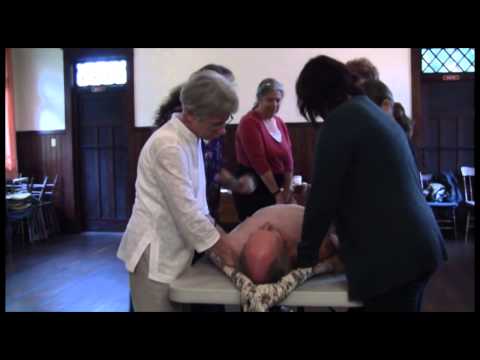 |
 |
 |
Part
1:
Moving the body |
Part
2:
Washing the hair,
face, and mouth |
Part
3:
Washing the body |
 |
 |
Part
4:
Dressing the body
Closing the eyes
and mouth |
Part
5:
Moving the body
into casket, or
Shrouding the body |
|
General
Timeline for
Post-death Care & Arrangements (PDF) |
Post-death
Physical Care (PDF) |
Click
here
to download the PDF,
which includes all of the following sections: |
Click
here to download the PDF,
which includes all of the following sections: |
| |
 |
|
Well
in advance of the death |
| |
 |
|
Just
before death |
 |
Within
the first few hours |
 |
Within
the first day or two |
 |
Within
3-4 days (just before
the burial/cremation) |
 |
Within
the next week to 10 days |
|
| |
 |
|
Dealing
with the body
|
| |
 |
|
Dealing
with rigor mortis |
 |
Supplies
for post-death care |
 |
Moving
the body |
 |
Using
dry ice and gel packs |
 |
Shrouding
the body |
|
The
National Home Funeral Alliance
(US) keeps an updated
list of podcasts. We also recommend
Donna
Belk on home funerals and How
to have a home funeral, and the "In the
Parlour" (trailer
available online) — as well as The
Art of Natural Death Care (Vimeo
online).
|
|
|
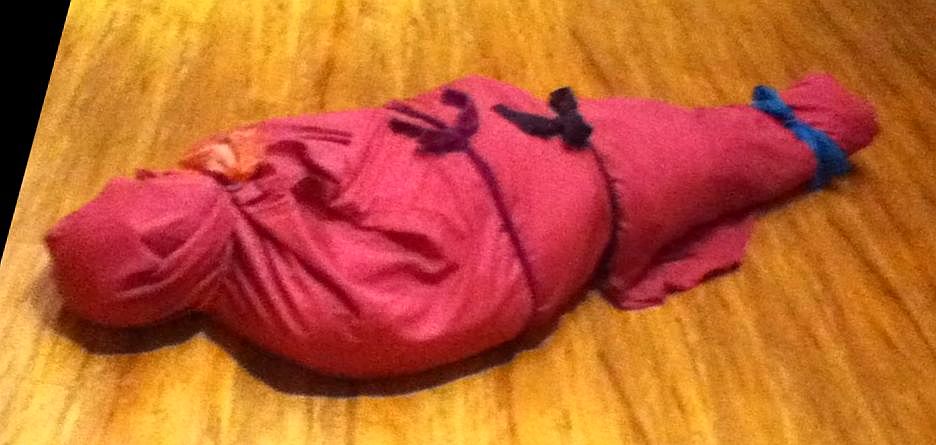
Mock
shrouding with queen-sized bedsheet and
four ties
|
(return
to top)

Shroud
Designs and Sewing Patterns
CINDEA
has provided 6 different designs for shrouds,
with graphic and written instructions. These
shroud designs have been approved for use at
the Royal Oak Burial Park Woodlands green burial
site (Victoria, BC, Canada).
It is possible that a traditional (non-green)
burial ground would accept a shrouded
body instead of a casket; and allow it to be
buried without a cement liner, because the ground
may not collapse over it. We
recommend that you
talk to your local cemetery about the use of
shrouds, especially if there is no green-burial
ground available in your area (see
Green
Disposition Options in Canada on our Post-death
page).



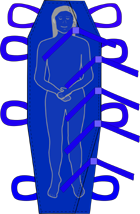

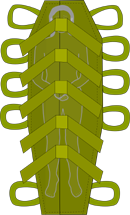
Click
here
to access all 6 of the downloadable patterns,
in PDF formats.
(return
to top)

Death
Journeyer's Remains
Note: further information is available on our
Resources
in Canada — Post-death page
and on our Greening
Death page (not completed
yet).
| If
choosing burial |
| |
 |
|
Kinds
of burials |
 |
Check
if any of your local cemeteries offer green
burials or hybrid burials (cement
liner on top, but not beneath — as
is traditional for Jewish and Muslim burials).
Also check what conditions they
require for the body and casket: for example,
a fully-green burial may not allow for any
metal on the body or in the casket —
either shrouds or caskets may be acceptable,
but both must be made from a biodegradable
material. You can check the
Green
Burial Council or the Green
Burial Society of Canada site for specific
areas in Canada where green burials are
available, or our Green
Disposition Options. |
 |
Full-body
burial at sea is still theoretically possible,
and would be considered 'green' — but
because of strict regulations and the expense,
it is now virtually prohibitive in Canada.
[Note:
the only Canadian-based information we have
found on burials at sea — where the
whole body is given to the sea, instead
of scattering ashes — is at Burial
At Sea. Two companies
in the U.S.A. have made 'full body burial
at sea' possible -- Golden
Gate Burial Services, California, and
New
England Burial at Sea, east coast of
U.S.A] |
| |
| |
 |
|
Requirements |
| |
 |
You
will need to obtain a Permit for Burial
or Cremation (received from
Vital Statistics, and issued for free after
both the Medical Certificate of Death and
the Registration of Death are filed).
[see CINDEA's Post-death
Legal information and Regulations for
access to documents for your province/territory.] |
| |
 |
If
you wish to transport the body yourself,
see the Legal
Information and Regulations on our Post-death
Resources page or apply to your local
provincial/territorial Consumer Protection
office to see if you require a Permit to
Transport the Body (these
may be available on-line). There
should be information accompanying the permit
to clarify what the requirements are for
transporting the body — including what
kinds of caskets can be used. |
| |
 |
Prior
to burial (especially a green
one), there may be a requirement
to remove any pacemaker, prosthesis or other
mechanical or radioactive device (check
with your chosen cemetery in advance).
In the case of a pacemaker (or
any other internal artificial items),
you may need to have the body taken to a
funeral home to remove the device, unless
that has been done at the hospital (if
the death journeyer died there).
It may be difficult to get the
funeral home to allow you to then take the
body home — if you have problems with
this, please feel free to contact
us for suggestions on how to get official
support. |
| |
|
 |
Cemetery
considerations |
| |
 |
Green-burial
sites, and perhaps some traditional cemeteries,
allow for shrouds or cardboard or pressboard
caskets that can be painted by the family/friends
with biodegradable paints (check
your local art stores for which brand would
be best). |
| |
 |
Some
cemeteries may allow the family/friends
to fill the grave — but if you choose
this option, make sure that enough soil
has been left by the graveside to do so.
Some may also allow the
family/friends to lower the body into the
grave — but paid employees will likely
need to be present for safety's sake. You
will need to negotiate with the cemetery
as to how they will supervise the lowering
of the casket — in order for them to
do so adequately, without interfering with
the burial ceremony. |
| |
 |
Find
out if a representative of the cemetery
needs to be present at the graveside ceremony,
and negotiate with them re how involved
they are. |
(return
to top)

| If
choosing cremation |
| |
 |
|
Kinds
of cremation
|
 |
Regular
cremation (by intense fire)
is usually available and inexpensive. |
 |
Open-air
cremations are traditional for some ethnic
groups (such as Hindus),
but are rarely available in urban areas
or even elsewhere in North America. There
is a movement to re-introduce them in Canada,
but we are not aware of any available at
the present time. |
 |
Resomation
or aquafication (bio-cremation
— by chemical dissolving; also called
alkaline hydrolysis) has 20 times
less carbon-footprint than regular cremation. There
are only a few units functioning in Canada
at the present time, but likely to be more
in the future. [Note:
Promession
(freeze-drying) is also being developed,
but not available in Canada to our knowledge
at this time.] |
 |
The
newest development is direct composting
of bodies, called recomposition
(intended for urban areas, but workable
elsewhere) — a project originally
referred to as the Urban Death Project and
now legalized in the U.S.A. as Recompose. It
is not available in Canada at the moment,;
but some of the next-stage of research is
being done here, and a facility is functioning
in Washington State (Seattle
times article on Recompose) It
has also been legalized in Colorado and
Oregon. |
| |
| |
 |
|
Timeframe |
| |
 |
In
most provinces/territories, a body cannot
usually be cremated — by law —
until 24-48 hours (usually
the latter) after the death; which
allows for a possible examination by the
coroner, etc., if deemed necessary after
the death. |
| |
|
 |
Requirements |
| |
 |
You
will need to obtain a Permit for Burial
or Cremation (received from
Vital Statistics, for free, after both the
Medical Certificate of Death and the Registration
of Death have been filed). [see
CINDEA's Legal
Information and Regulations for access
to documents for your province/territory.] |
| |
 |
If
you are transporting the body yourself to
the crematorium, apply to your local provincial/territorial
Consumer Protection office to see if you
require a Permit to Transport the Body (these
may be available on-line or check our Legal
Information). There
should be information accompanying the permit
to clarify what the requirements are for
transporting the body — including what
kinds of caskets can be used. |
| |
 |
Prior
to cremation, any pacemaker, prosthesis
or other mechanical or radioactive device
must be removed, because they are likely
to explode in the cremation chamber. In
the case of a pacemaker (or
any other internal artificial items),
you may need to have the body taken to a
funeral home to remove the device, unless
that has been done at the hospital (if
the death journeyer died there).
It may be difficult to get the
funeral home to allow you to then take the
body home — if you have problems with
this, please feel free to contact
us for suggestions on how to get official
support. |
| |
|
 |
Other
considerations |
| |
 |
It
may be possible to rent a regular casket
for visitation purposes, but the body will
generally be in a cardboard casket when
cremated (at present, a hard
container is required so shrouds can't be
used). If you choose
only the cardboard casket, it can be painted
(with biodegradable paints)
by family/friends. |
| |
 |
Crematoriums
often have chapels where a service can be
held at the time of the cremation —
sometimes available free of charge. |
| |
 |
Some
crematoriums may allow a family member to
push the button that starts the cremation
fire, and/or otherwise witness the cremation
— but you will need to specifically
ask if this is possible. There
may be an added charge for witnessing the
cremation and/or pushing the button, although
not necessarily. |
| |
|
 |
Scattering
of ashes |
| |
 |
There
are generally no laws prohibiting the scattering
of ashes (actually ground bone) by land, sea, or air — but
you should check the municipal by-laws.
|
| |
 |
There
may be specific conditions for scattering
in public parks, or rules that ashes can
only be buried there — which then requires
a permit. |
| |
 |
You
may need a special permit to scatter them
at sea (at least within the
national boundary). |
| |
 |
Ashes
should never be scattered on private property
without permission (including
commercial private property — golf
courses, etc.). |
| |
 |
Ashes
are usually scattered in a place significant
to the death journeyer or family; but it
is wise to remember that the use of that
land may change in the future (for
example, be dug up to build housing, etc.). |
 |
Scatter the ashes over a relatively
large area. Too many ashes
in one small spot can kill the vegetation
above and around them — this includes
ashes in a biodegradable urn (see
Why
Burying Ashes is Harmful to the Environment) |
| |
|
 |
Urns
for ashes |
| |
 |
Generally,
1 pound body weight equals 1 cubic inch
ash |
| |
 |
Unless
special urns are arranged in advance, the
ashes will come to you in one or two cardboard
boxes or plastic bags/tubs (depending
on the size of the death journeyer).
You should always check to make
sure that the box or bag is labeled with
the death journeyer's name, or some other
coding that ensures that you have the right
person's ashes. |
| |
 |
Urns
can be made of almost any substance. Your
local funeral homes and crematoriums are
likely to have a wide variety. You
may wish to have an artisan friend make
one (or more) for
you, which may incorporate some of the ashes.
If you plan to bury the ashes
in a green-burial ground or a garden, the
urn will need to be biodegradable. [Note:
if you can't find a biodegradable urn locally,
see the Green Burial Council's page 'Find
GBC Provider' — at the bottom under
'Approved Products', check the pull-down
menu for 'urns'.] |
| |
 |
If
you choose to bury the urn in a specific
piece of land, make sure that you have permission
to do so. |
| |
 |
Your
family members may choose to divide the
ashes amongst them, as they may wish to
either each retain part of the ashes, or
scatter them in different places. Usually,
arrangements can be made with the crematorium
to have the ashes divided into several containers
(either cardboard boxes,
or pre-purchased urns or ones that you provide
yourself). Although holding
the ashes for a while can be comforting,
many families find that it then becomes
awkward to decide what to do with them for
the long term, and when to make that decision.
However, if the family wants
to scatter or bury them together, you might
want to pre-select a date — possibly
the first anniversary of the death —
to jointly make a decision as to the final
disposition of the ashes. |
(return
to top)
|























